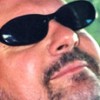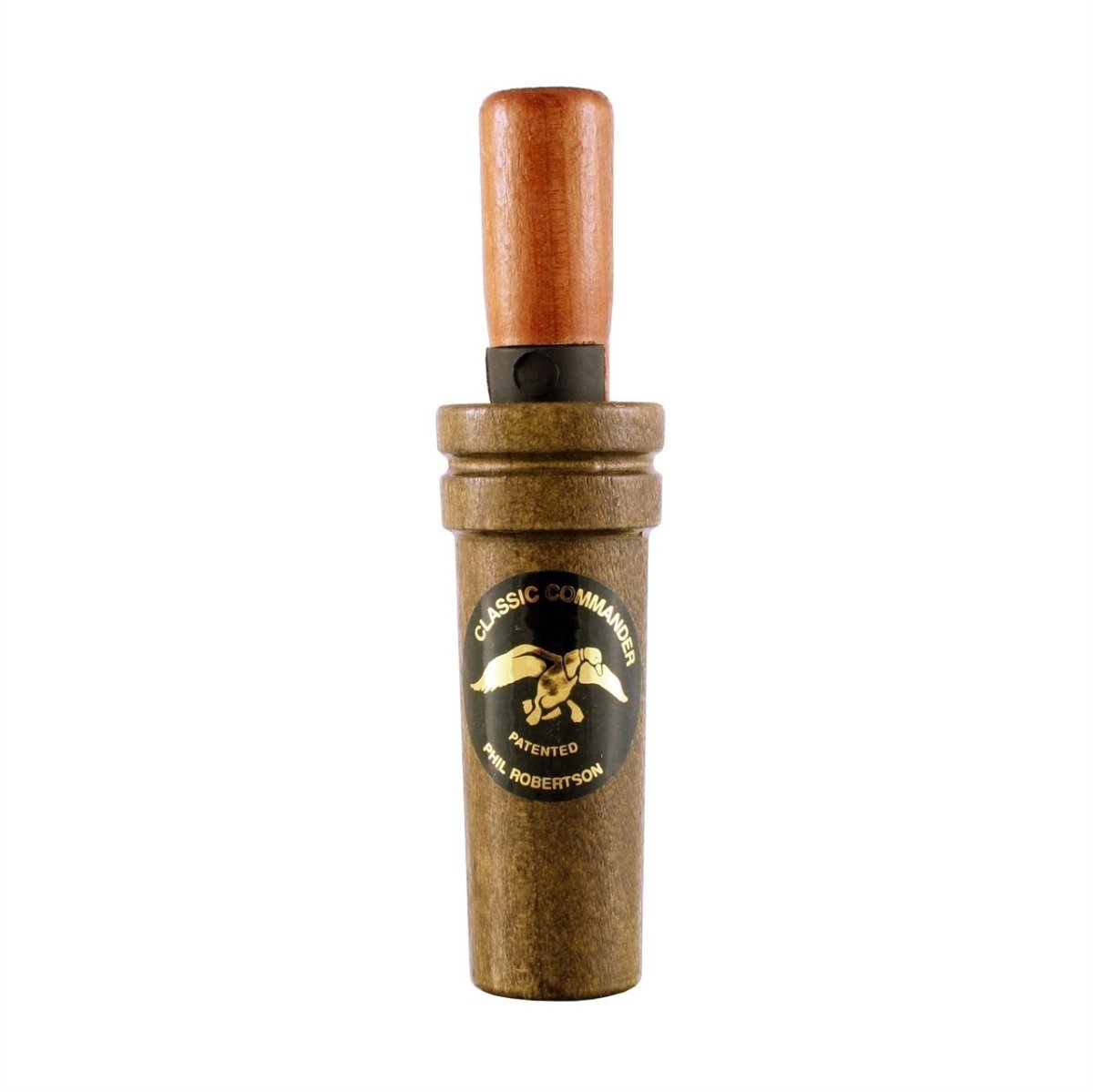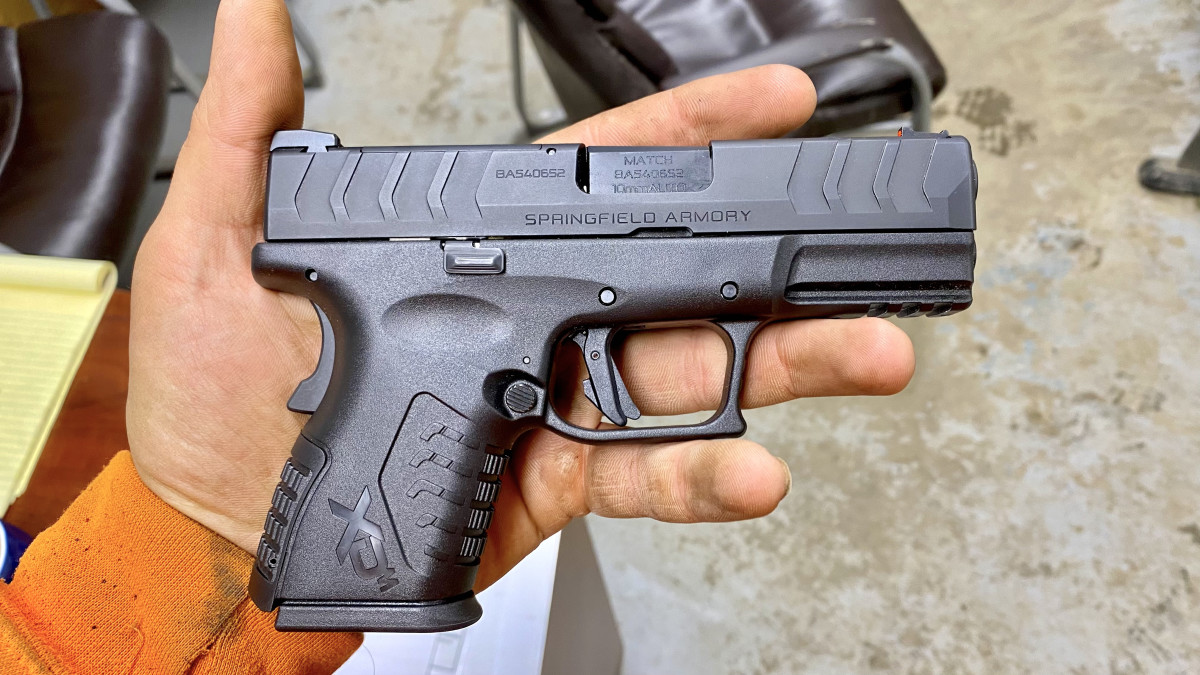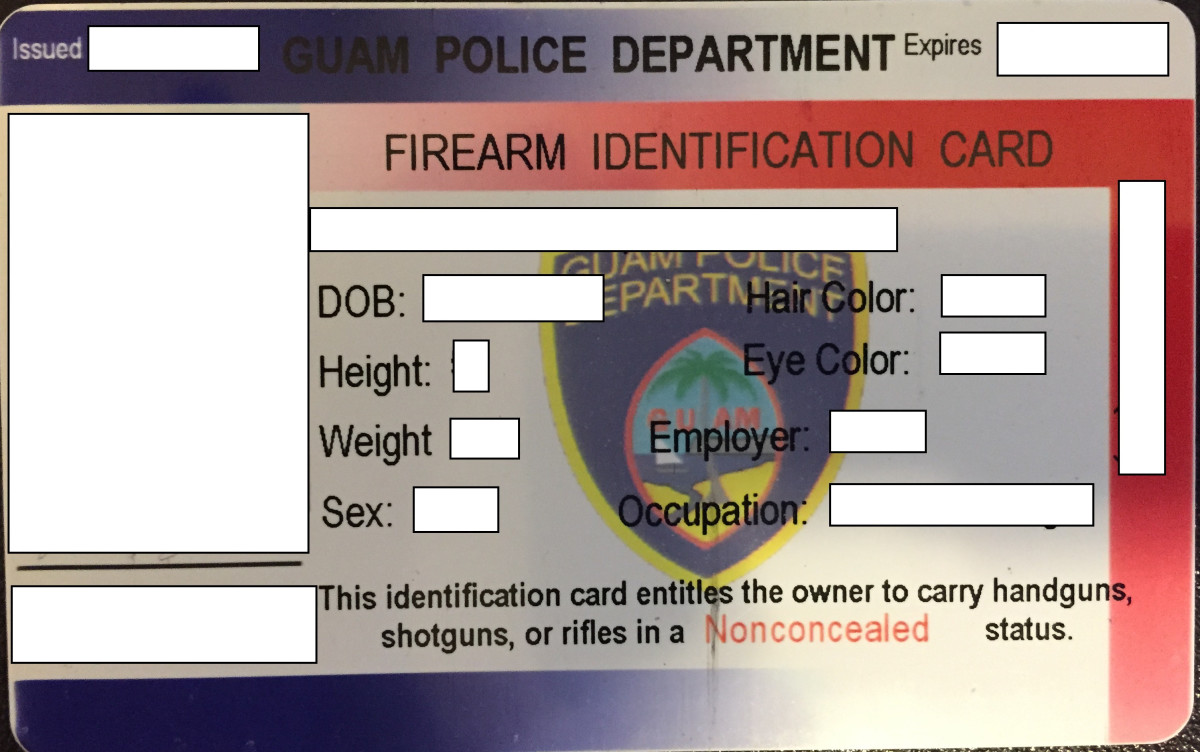Sound attenuation at shooting ranges
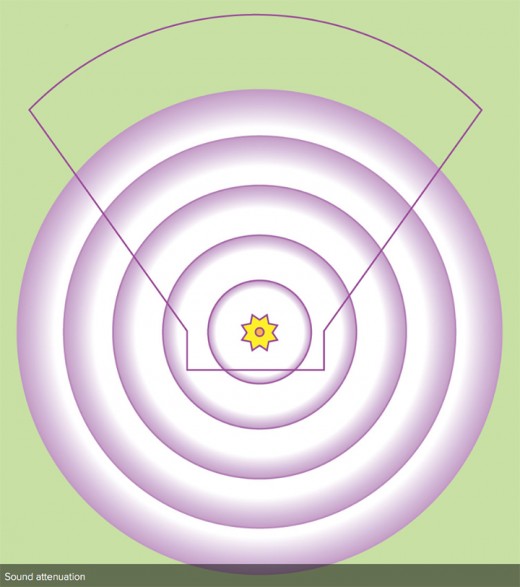
What is sound attenuation?
Attenuation is a general term that refers to a reduction in strength of a signal or sound. Specifically, sound attenuation refers to the reduction of sound and noise, whether by natural or artificial means. In this discussion, I will be presenting some of the many alternatives for reducing the sound and noise attendant to shooting ranges.
Why care about sound attenuation?
Sound becomes noise when it becomes an irritant or a nuisance. One might enjoy the sound of a calming concerto, but not that of the garage band practicing next door. The early morning chirping of birds may set one’s mood, whereas the roaring of an early morning leaf blower may set one’s teeth on edge. Throughout the industrialized world, the most commonly encountered types of noise include those from aircraft, highway vehicles, trains, lawn equipment, gunfire, and facilities of manufacturing or heavy industry. As an increasing percentage of population migrates to cities and developing suburbs, more residents are continually exposed to noise — so much so that the term noise pollution has been coined to refer to the growing worldwide problem.
Noise pollution can have severe adverse physical and psychological effects on humans, including heightened stress levels, hypertension, tinnitus, noise-induced hearing loss, distraction, sleep disturbances, and disruption of normal daily routines.
Upon recognition of America’s growing noise problem — and the potential health impacts on people — the Noise Control Act of 1972 of the Federal government of the United States authorized the Administrator of the United States Environmental Protection Agency (USEPA) to establish national community noise standards to protect the nation’s citizenry. The resultant community noise standards of the USEPA are entitled Information on Levels of Environmental Noise Requisite to Protect Public Health and Welfare with an Adequate Margin of Safety, published in March 1974, and are available online. (Similar standards for Europe were espoused by Dieter Gottlob of Germany’s Federal Environmental Agency in his December 1995 article for Noise/News International, also available online.)
Acknowledging the particular problem of noise in the workplace, both the United States Department of Labor’s Occupational Safety and Health Administration (OSHA) and the Canadian Centre for Occupational Health and Safety (CCOHS) have developed additional standards addressing sound in the work environment.
Thoughtful planning and design processes directed at sound (and noise) attenuation can best serve the long-term health, safety and welfare of the public, in their homes, and at work and play.
Why focus on shooting ranges?
Shooting ranges are valued recreational resources for communities, but, due to the very loud and explosive nature of firearms, are also generators of significant levels, amounts, and spikes of sound — sound that may constitute noise for neighboring citizens. It is therefore in the best interest of both the shooting range and the neighboring citizens to develop and apply effective methods of accommodating or attenuating the sounds of the shooting range.
As previously rural or exurban districts see increased residential development, existing shooting ranges may accumulate new neighbors unhappy with historic sound levels. The expanding encroachment of development may also hinder the ability of finding a sufficient ‘footprint’ for an effective new shooting range. In both instances, the application of tested sound attenuation practices may point the way to resolution.
Understanding sound
Our task of understanding the nature of sound and noise in this particular discussion is simplified by the fact that virtually all shooting range sounds are point-source sounds. That is, those sounds typically emanate from the single point source of a firearm’s muzzle opening. As a specific shooting range is used by multiple shooters over time, potentially at multiple shooting stations, a number of point sources arise at individual shooting positions. Such point sources typically create sudden and abrupt sounds that rapidly spike to a high volume, and just as rapidly diminish and dissipate. Those sounds radiate outward from each point source in ever-expanding spheres, akin to ripples radiating outward from pebbles tossed into a still pond. Of course, as multiple shooting positions create multiple intermittent sounds, those outward radiating spheres of sound overlap and combine to create an overall ‘landscape of sound’ or ‘sound profile’.
Sound pressure
Sound is a pressure created in air by the oscillations and impacts of successive air molecules that have been set in motion by such occurrences as the explosive force of gunfire, or the vibration or oscillation of vehicles. That pressure, eventually felt by our eardrums, becomes the sound we perceive. Sound pressure travels in wave form, having both a frequency (the number of repetitions of waves in sequence) and an amplitude (the overall energy level). As sound emanates through the elastic medium of the atmosphere, it can be affected or dampened by that atmosphere. Thus, sounds emanate differently through thin, cold, dry air than they do through thick, hot, humid air. Sound analysts therefore strive to adhere to ‘baseline’ measurements that relate directly to the ambient environment of one atmospheric pressure. The dispersion of sound is also affected by wind patterns; for that reason, most sound measurements are considered reliable and useful only if taken during periods of relatively still air.
Sound pressure is the pressure variance from an ambient (or background) equilibrium, experienced by humans as a result of a sound being generated. A gun is shot, and the resulting sound wave travels toward the hearer as a sound pressure wave that is greater than the background or ambient equilibrium (or ‘sound landscape’) existing in the surrounding environment at the time of the gunshot. For example, one may clearly hear the gunshot over the low rumble of nearby road traffic or above the murmuring of nearby conversation.
Human perception and the decibel
Humans perceive sound frequency as the variation from low-pitch to high-pitch. We perceive sound amplitude as volume or loudness. But human hearing does not receive or process sounds equally well or uniformly along all frequencies and all volumes. Though we can perceive sounds as low-pitched as 20 Hz (20 cycles/second) and as high-pitched as 20,000 Hz (20,000 cycles/second), human hearing is most sensitive around frequencies of about 2,000 Hz (2,000 cycles per second). To illustrate relative pitch, a piano will typically range from a low pitch of around 28 Hz to a high pitch of almost 4,200 Hz.
An early measure of sound level (intensity, loudness, or volume) was the bel, named to honor sound pioneer Alexander Graham Bell. However, over time it became clear that the measurement of increments of sound ten times as fine — in decibels — would have more practical widespread application. Decibels, or dB, are measurements of the relative difference between sounds having different sound pressures, which are thus perceived by humans as being of different loudness. The decibel scale is not a linear scale, but a logarithmic one. Thus, a variation of 10 dB signifies a ten-fold change in sound pressure. Humans typically register a 10 dB sound pressure increase as a rough doubling of loudness.
While we can perceive sounds as quiet as only 1 dB, quieter than the gentle rustle of leaves, and as loud as 160 dB, as deafening as a nearby jet engine (and beyond the level of pain for most of us), we tend to be most adept within a narrower ‘working range’ from about 30 dB to 120 dB. As one would expect, our perception of sound also varies by age and circumstance.
Since human perception of, processing of, and reaction to sounds of varying frequencies and volumes is not linear, fields devoted to sound measurement and analysis use different ‘weighting’ to correlate measured sounds more closely to their likely eventual effects on human hearing and comfort. The three recognized weighting profiles — A-, B-, and C-weighting — subtly adjust the overall measured or observed sound spectrum to closely match the spectrum of human perception. Sound pressure levels of up to about 55 dB are typically A-weighted, those from 55 dB to 85 dB are typically B-weighted, and those above 85 dB are typically C-weighted. Sound technicians will therefore typically designate an A-weighted sound pressure level reading as 45dBA, for example.
Equivalent sound level
In a world punctuated by sounds of all types, sources, intensities and directions, it can be quite a complicated task to ascertain the net contributory effect of any single sound on humans. In examining a shooting range with many different shooters firing repetitive rounds in varying directions from multiple shooting positions, the task may still prove too daunting for our analysis. Luckily, the sound analysis field has developed a tool to assist us: the equivalent sound level.
Designated by LAeq, an equivalent sound level is just what one might expect: a single A-weighted sound level that has been calculated to be equivalent — in terms of its impact on human hearing — to a particular ‘sound bite’ or limited ‘sound profile’. The methodology of developing an equivalent sound level allows the sound technician to translate a limited but highly variable sound profile into a singular steady-state sound element. We are thus able to compare extremely diverse sound profiles to assess their relative impact on humans.
Here’s how an equivalent sound level is determined, in specific detail: A sound analyzer records the A-weighted decibel level (dBA) of sounds received up to 16 times per second, then converts those decibel level readings to sound pressure levels (SPLs) by means of the proper formulaic calculations. It then sums all of those sound pressure levels (SPLs) and divides the total by the number of measurements taken, to arrive at an average sound pressure level (SPLavg) across the entire time interval, which it then converts back into A-weighted decibels (dBA). The resulting LAeq is the straight-line-level equivalent of all of the sound pressure energy received by the analyzer, as if it was received as a continuous unchanging sound.
Prevailing standards and sound levels
As mentioned previously in this discussion, a number of agencies such as the USEPA, OSHA, CCOHS and Germany’s Federal Environmental Agency, among others, have developed standards for what should be considered safe and unsafe ranges of sound and noise. Those standards typically cite an equivalent sound level (LAeq) of <55 dB as necessary to protect public heath and welfare for residential areas having outdoor activity spaces, such as backyards, play fields, and so on. A number of US states have incorporated similar sound and noise standards into their zoning or building codes, or into other regulations governing shooting ranges and/or hunting activities.
At substantially higher sound levels, pain, injury and permanently debility may result. Such agencies as OSHA, for example, have established the following maximum permissible exposure times for workers at different sound levels: 8 hours at 85 dB; 4 hours at 88 dB; 2 hours at 91 dB; 1 hour at 94 dB; and 30 minutes at 97 dB. From these standards, it becomes obvious why ear protection is critical at shooting ranges.
Sound sources that we might encounter day-to-day may be roughly ranked in intensity, loudness or volume as follows:
10 dB Quiet rustling of leaves in relatively still air
20 – 30 dB Soft whisper
40 dB Hum of a small electric appliance
50 dB Ambient or background household noise
60 dB Normal conversation
70 dB EPA-identified maximum to prevent long-term hearing deficiency
70 – 80 dB Busy street noise
85 dB Hearing loss over long-term intermittent exposure
90 – 100 dB Piano, passing subway train
110 – 120 dB Jackhammer, car horn
130 dB .22 rifle shot
130 – 140 dB Threshold of pain for most humans
150 – 160 dB Jet aircraft exhaust
150 – 170 dB Shots from many long guns, such as rifles and shotguns
171 dB .30-06 rifle shot
From the above, it is easy to see that rifle shots that range from 130 dB to 171 dB far exceed the prevalent limit of 55 dB deemed necessary to protect public health and welfare for residential areas, and far exceed sound levels that may cause pain, injury, and permanent debility. Therefore, the challenge for shooting ranges is to develop and implement methods of attenuating, mitigating or blocking such high sound levels from adversely impacting neighbors.
Understanding sound transmission
As mentioned earlier, shooting range sounds typically emanate from the single point source of a firearm’s muzzle opening. Multiple shooters at multiple shooting stations create a number of such point sources. Sounds radiate outward from each point source in ever-expanding spheres, and those outward radiating spheres of sound overlap and combine to create an overall ‘landscape of sound’ or ‘sound profile’.
Rifles and shotguns are obviously directional; the blasts of pellets and sound are thrust forward in the direction of aim. However, unlike the shot or pellets which continue to travel generally toward their target, the sound quickly spreads, emanating in all directions. For purposes of sound analysis, therefore, the sounds of shooting are considered non-directional point sources. That is, someone behind the shooter hears the shot virtually the same as someone beside the shooter, and virtually the same as someone before the shooter (and hopefully out of the direct line of fire!).
Sound dissipates with distance, as the sound pressure waves lose energy to the atmosphere they pass through. Sound level will decrease as the square of the distance from a non-directional point source. Thus, a doubling of the distance from the non-directional point source will decrease the sound level to one-quarter its original level. Bearing in mind the fact that the decibel scale is logarithmic rather than linear, a doubling of the distance will generally reduce the perceived sound only by about 6 dB. If, for example, one hears a gunshot as a sound level of 160 dB at a 10-foot distance, then another should perceive that same gunshot as only about 154 dB at a 20-foot distance. Extending our calculation further, we can determine that the gunshot will seem to be at a sound level of about 148 dB at 40-foot distance, and at about 142 dB at 80-foot distance, and so on. If we extend our calculation further, we can see that even at a distance as great as half a mile, the perceived sound will still remain above 110 dB, and will thus constitute noise and nuisance.
Sound attenuation measures
The above paragraph displays the inherent flaw in our first sound attenuation measure: distance. If we are to employ only distance as a sound attenuation measure, then our shooting range would need to be miles away from any residential areas to insure no adverse noise or nuisance impact. While such a strategy might work in vast unpopulated stretches of the American West (and where shooters would not mind extreme commutes to and from a shooting range), it is infeasible in suburban or urbanized areas, or where development and increasing residential density continue.
We must next turn to a second sound attenuation measure: topography. Situating a shooting range in a deep valley or beyond a steep escarpment can serve to contain or deflect sound that would otherwise become noise or nuisance to neighboring residents. However, such idealized topographical conditions are likely very rare and difficult to find and obtain, and in any case are not available to the shooting range already established on relatively level terrain or in growing or spreading communities.
Our third sound attenuation measure is that of artificial terrain: creating earthen berms and backstops that at least partially contain the sound of a shooting range. Such earth forms may also be used at ranges to capture spent and stray shells, pellets or target debris. Earthen berms are limited in their effectiveness by their continuity, height and depth. If they are not fully continuous in surrounding or enclosing the sound sources, sounds will simply radiate around them or through gaps between them. Higher, deeper (thicker) berms are more effective at blocking or dispersing radiating sounds than those that are lower and shallower (thinner). However, even fully continuous high and deep berms will only absorb or deflect a portion of the sound emanating from a shooting range. Acoustic designers versed in the field should be consulted in planning and designing a shooting range’s proposed earthen berms, backstops or other sound attenuation devices, to insure maximum efficiency and effectiveness in achieving desired goals.
Yet another sound attenuation measure is landscaping. This is perhaps the most widely used measure of all, simply because plentiful trees are often already part of a shooting range’s environment. But tree stands actually prove to be of relatively limited help in attenuating shooting range sound. The fine leafing and branching of deciduous trees and dense evergreens are most effective against higher frequency noises, and function best when planted in dense and deep stands. A 1,000-foot wide band of dense landscaping may reduce sound levels by only about 20 dB. When deciduous trees lose their leaves, or where branching begins only about 15 to 20 feet above the ground, any sound attenuation disappears. On level ground, where shooter and observer are generally on the same level, the sound from a rifle or shotgun muzzle at about 8 feet from the ground will simply travel a straight line directly to the observer. A fine-textured non-reflective ground cover at a shooting range, such as rough grass, weeds, etc., will also tend to absorb a very small amount of range sound.
We now come to the use of structured solid barriers for sound attenuation. These can vary from perimeter walls or fences enclosing a complete range, to baffled sound walls adjacent to shooting lanes or positions, to nearly-complete enclosure of shooting positions themselves. Yet another variant is that of sound-baffled rifle and shotgun tubes through which individual weapons are fired — sort of an unattached silencer, if you will. The objective in each instance is to place a solid barrier between shooter and receiver to interrupt the travel of sound. Generally, the overall effectiveness of such structured solid barriers will increase with barrier height, will increase with barrier continuity and integrity, and will increase as the barrier is moved closer to either the point source of the sound or to the receiver of the sound. (Since most shooting ranges will be concerned about sound impact in all directions, moving barriers closer to the receivers of the sound, i.e. all of the neighbors, will likely prove impractical and costly.)
The Range Source Book of the National Rifle Association (NRA) also offers limited guidance on earthen berms, backstops, baffles and enclosures.
The ultimate sound attenuation measure for a shooting range is the complete enclosure of the entire range within a sound-proofed or sound-enhanced structure. Just as structures today are often designed and constructed to house sound studios, radio stations, and a wide range of exceedingly noisy industrial processes, they can be effectively designed and constructed to completely contain or mitigate the noises associated with a shooting range. Often, though, such solutions prove exceedingly expensive considering the economic realities of many shooting ranges, as well as somewhat contrary to the traditional ‘great outdoors’ ambience of shooting range activity.
However, it may well be that the dynamics driving the establishment and continuing operation of shooting ranges are changing. As communities continue to develop and expand, sufficiently large parcels sufficiently far from neighboring residents for open-air shooting ranges may be harder and more expensive to obtain and maintain. As those communities continue to establish and refine regulations governing noise and nuisance, open-air shooting ranges may find themselves less able to meet such regulations, and thus less welcome and less viable. As advances continue in layout, design, construction and building materials for the enclosure and sound-proofing of shooting range structures, overall economics may increasingly favor compact enclosed shooting ranges over sizable open-air shooting ranges.
About the Author
Richard L. Zimmerman is a licensed architect and urban planner with over 40 years experience in planning and designing buildings and facilities of all types and sizes. Mr. Zimmerman has written extensively on environmental and sustainability issues.
Bibliography
Canadian Centre for Occupational Health and Safety. OSH Answers Fact Sheets: Noise. Web.
De Chiara, Joseph, & Callender, John Hancock. Time-Saver Standards for Building Types. McGraw-Hill, New York, NT. 1973.
De Chiara, Joseph, & Koppelman, Lee. Urban Planning and Design Criteria. Van Rostrand Reinhold Company, New York, NY, 1975.
Everest, F. Alton. Master Handbook of Acoustics, Fourth Edition. McGraw-Hill, New York, 2001.
Explain That Stuff! website, Sound Level (Decibel) Meters.
Gottlob, Dieter. Regulations for Community Noise. Federal Environmental Agency, Berlin, Federal Republic of Germany, published in Noise/News International, Vol 3, No 4, Dec 1995.
Hansen, Scott D. Policy Track: Environmental Issues: Sound Attenuation Techniques and Technology. Fourth National Shooting Range Symposium, Phoenix, AZ, 2000.
Jacobsen, Finn, & Poulsen, Torben, & Rindel, Jens Holger, & Gade, Anders Christian, & Ohlrich, Mogens. Fundamentals of Acoustics and Noise Control. Department of Electrical Engineering, Technical University of Denmark, 2011.
Lynch, Kevin. Site Planning. The MIT Press, Cambridge, MA, 1962.
Merritt, Frederick S. Building Construction Handbook. McGraw-Hill, New York, NY, 1975.
National Rifle Association. The Range Source Book. 1999.
Peters, R.J., & Smith, B.J., & Hollins, Margaret. Acoustics and Noise Control, Third Edition. London. Routledge, 2011.
Scientific Committee on Emerging and Newly Identified Health Risks, established in 2004 by the European Commission. Green Facts: Facts on Health and the Environment. Web.
United States Department of the Interior, National Park Service. Plants, People and Environmental Quality. Washington, DC, 1972.
United States Environmental Protection Agency. Best Management Practices for Lead at Outdoor Shooting Ranges. New York, NY, 2005.
United States Environmental Protection Agency. Information on Levels of Environmental Noise Requisite to Protect Public Health and Welfare with an Adequate Margin of Safety. Washington, DC, 1974.
World Health Organization. Guidelines for Community Noise. Web, 1999.
